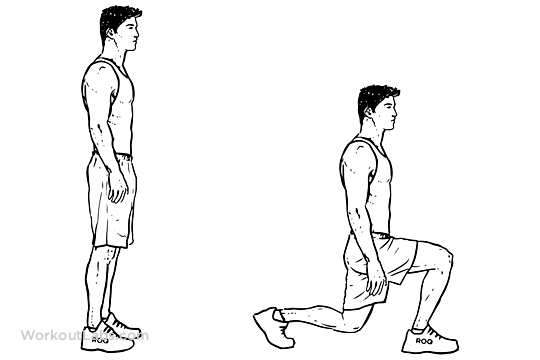This is an advanced exercise that can make equipment room purists turn up their noses: any trainer would be a fool to include this exercise in the routine of a guy who has just joined the gym.
The deep lunge or deep lunges is a very functional variant of the classic lunge, which can be performed with both a forward and backward lunge, but which is better to learn first in the back, then in the front to avoid unpleasant inconveniences to the knees.
How do i run the standard version?
Before leaving we must summarize the key points of the classic lunge (we choose the forward or front lunge version):
- Depart from standing station with legs together and hands on hips.
- Step forward with one leg (we will be in lunge position).
- From here go down on your knees until the knee of the rear leg touches the floor.
- As you exhale, push on the forward leg and return to the starting position.
- Perform the same movement by reversing the advancing leg.
All this must be done trying to keep the back straight without placing the head and shoulders before the pelvis, with the control and activation of the abdominal brace. It is also important not to overload the knee of the forward leg, which must always be approximately in line with the corresponding heel.
This exercise is already in itself a must in functional training, working on the gluteus, on the extensors and on the hip stabilizers and on the abdominal belt, without neglecting an important component in terms of balance and proprioception.
How do you do the deep version?
As happens in many exercises, there is a time for teaching and classical execution, and a time for adapting to sport: how many times during a sporting action do we have the opportunity to control the execution of the movements?
Think of those who use deep lunges all the time: how many times is a fencing practitioner forced to perform lunges during a competition?
The jabs do not always take place in full control of the movement, with the result that at that moment a technically imperfect lunge is being performed; this will continue to repeat itself throughout his career because the movements of fencing like those of all sports are dictated by the situation.

For this and other reasons, the deep lunge variant can make sense in those advanced athletes if it is conscientiously inserted into the program: but now let's see how it is performed in a "back lunge" version.
- We will start by performing a classic lunge backwards, finding ourselves in the kneeling position.
- From here, we take the advanced knee well beyond the line of your foot.
- At the same time we move the torso forward by placing the chest on the advanced quadriceps.
- With all of your weight placed on the forward leg, assume a deadlift position and straighten the hip, bring the rear foot alongside the other, returning to a standing position.
- It is essential that the foot of the advanced leg remains glued to the ground, from heel to toe.
Common mistakes
As you can guess from the description it is an exercise that requires a lot of control and balance. Between point 1 and point 2 it is necessary to pause for a fraction of a second to have the execution well under control.
Furthermore, the backward version is much easier to perform because while the lunge is performed by backing away, the increase in depth is performed by advancing, making the pause between the lunge and the next movement mandatory.
Performing the same thing for the first time in a front lunge risks being misleading: combining the two movements would risk performing the deep lunge too stressful for the knee joint.
Advantages of deep lunges
This version leads to multiple advantages: the depth of movement activates the glute to a greater extent while the ascent phase is a mix between a lunge and a monopodalic deadlift, which involves the hip extensors much more than in the classic version.
But that's not all: this exercise works a lot on the mobility of the hip during the transition from the kneeling position to the deeper one, and above all on the mobility of the ankle joint that is required to keep the heel on the ground throughout the exercise.
This mix of mobility and muscle involvement makes this version of the lunge an excellent prerequisite for learning the pistol squat, which requires balance, hip and ankle joint mobility, good management of monopodalic exercises: all characteristics very well involved in the deep lunge.
What we can say at the end of the day is that the deep lunge is a very particular lunge, stressful for the knee joints (if performed incorrectly both in terms of technique and periodicization) but which can give numerous satisfactions. both to athletes of situation sports who perform similar movements (fencing, football, soccer, tennis, judo) and to those who want to improve the joint mobility of the hips and ankle by doing it in a dynamic and training way! An excellent functional exercise to learn and put in our cultural baggage.
Our articles should be used for informational and educational purposes only and are not intended to be taken as medical advice. If you are concerned, consult a health professional before taking dietary supplements or making major changes to your diet.


























